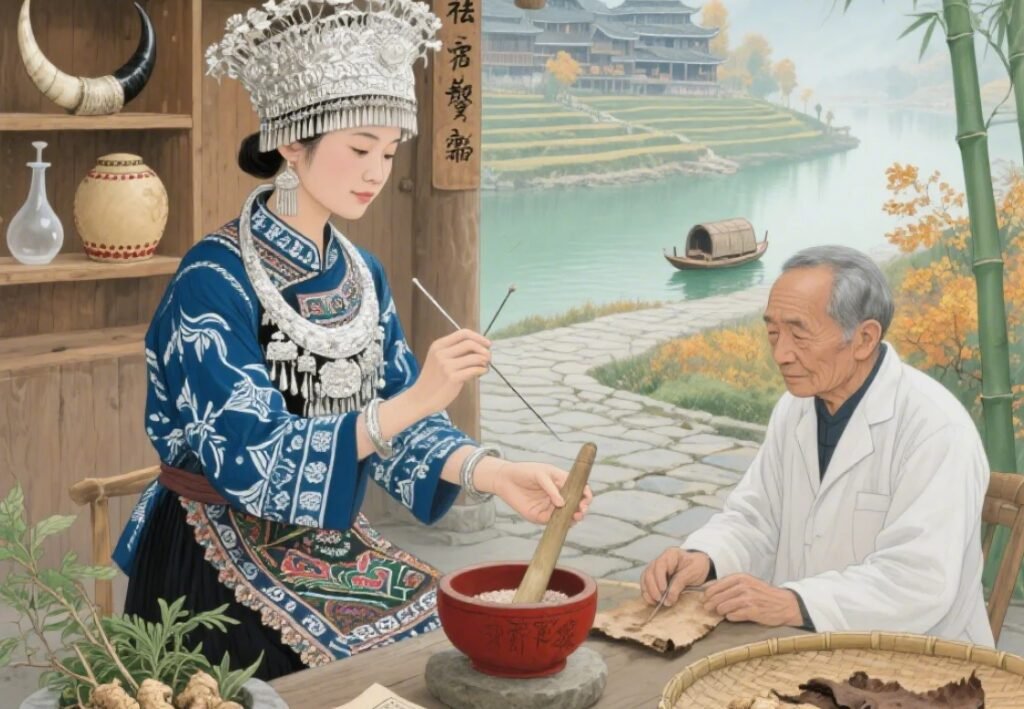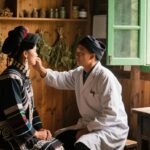Guojing She (Common Cold)
[Overview] In Miao medicine, the common cold is called Guojing She. Headache, aversion to cold, and alternating chills and fever all fall under this category.
In Traditional Chinese Medicine, the common cold is an external contraction disorder caused by pathogenic wind invading the Wei exterior, characterized by nasal congestion, rhinorrhea, sneezing, cough, headache, chills, fever, generalized discomfort, and a floating pulse.
In Western medicine, upper respiratory tract infections, influenza, and other respiratory illnesses presenting with cold-like symptoms may be approached using this syndrome’s diagnostic and (used in traditional contexts) principles.
[Symptoms in Miao Medicine] Guojing She is considered a minor syndrome and is divided into two types: Wind-Cold Cold and Wind-Heat Cold.
[Etiology] This condition is most often triggered by invasion of wind, cold, or heat toxins.
[Pathogenesis] Wind, cold, and heat toxins enter through the mouth and nose, injure qi and blood, generate heat from blood stagnation, and invade the lung-Wei. Wind pathogen can penetrate via the nasal or skin pores; cold pathogen lodges at the lung-Wei, disrupting exterior defense and obstructing lung qi dispersion—leading to symptoms of Wind-Cold Cold such as aversion to cold, headache, and nasal congestion. Heat toxin rising causes sore throat; phlegm-damp obstruction leads to cough.
[Diagnosis]
Diagnostic Criteria: (1) Prominent exterior and nasal-pharyngeal symptoms including nasal congestion, rhinorrhea, sneezing, throat itch, sore throat, headache, limb and joint soreness, aversion to wind or cold, possibly accompanied by fever. (2) Typical disease course of 3–7 days. (3) Can occur in any season but is most common in winter and spring.

Auxiliary Examinations: Complete blood count and chest X-ray can assist in diagnosis.
[Differential Diagnosis] Anwo (Cough) Both are external contraction disorders. In Miao medicine, Anwo refers specifically to cough with expectoration caused by rebellious lung qi, whereas Guojing She, although it may include cough, is primarily marked by nasal congestion, rhinorrhea, sneezing, throat itch or pain, headache, limb soreness, aversion to wind or cold, and fever.
[Syndrome Differentiation and Treatment]
Wind-Cold Cold
Clinical Manifestations: Aversion to cold, mild fever, headache, absence of sweating, limb soreness, nasal congestion, sneezing, rhinorrhea, cough with thin clear phlegm.
Channel Pattern: Cold-Channel Disorder.
Treatment Principles: Release the exterior with acrid-warm herbs; ventilate the lung and arrest cough.
Formula & Explanation: • Guizhi (Cinnamomi Ramulus) 10 g: warms and disperses cold, relieves pain, releases the exterior. •
Mujiangzi (Cinnamomi Cortex) 20 g: warms the middle, disperses cold, regulates qi, relieves pain, detoxifies. •
Laliao (Polygonum hydropiper) 20 g: warms and disperses cold, moves qi, drains dampness. •
Xingren (Prunus armeniaca) 10 g: moistens lungs, stops cough, calms wheezing. •
Qianhu (Peucedani Radix) 10 g: disperses wind-heat, descends qi, transforms phlegm. Decoction, taken orally.
Wind-Heat Cold
Clinical Manifestations: Headache, high fever, red eyes, cough with yellow viscous phlegm, thirst with preference for cold beverages, scanty dark urine.
Channel Pattern: Hot-Channel Disorder.
Treatment Principles: Clear heat and moisten the lungs; clear the lungs and transform phlegm.
Formula & Explanation: • Jinyinhua (Lonicerae Flos) 20 g:
clears heat, detoxifies, cools blood, stops cough. •
Gegen (Puerariae Radix) 15 g: releases exterior, reduces fever, generates fluids to quench thirst. •
Shegan (Belamcandae Rhizoma) 15 g: clears lung heat, transforms phlegm, drains dampness, detoxifies. •
Bohe (Menthae Haplocalycis Herba) 15 g: disperses wind-heat, clears the head and throat. Decoction, taken orally.
[Preventive Care]
Maintain regular rest and activity; protect against wind and cold in winter and spring; avoid excessive cooling in summer; ensure good indoor ventilation.
Exercise regularly to strengthen resistance.
Those susceptible to colds may daily massage Yingxiang (LI 20) and consider tonifying formulas to stabilize the exterior.
During cold epidemics, avoid crowded places to (helps maintain) cross-infection.
During illness, rest adequately; severe cases should remain bedridden; mild cases should isolate; drink warm water, adopt a light diet, and monitor temperature and perspiration.
[Commentary] Miao medicine holds that the common cold is chiefly caused by external pathogens—wind-cold or heat toxins invading the mouth and nose, injuring qi and blood, and generating heat in the lung-Wei. Clinical features focus on exterior and nasal-pharyngeal symptoms. Treatment emphasizes releasing the exterior with appropriate herbs, ventilating the lungs to arrest cough, clearing heat, and transforming phlegm.


Leave a Reply